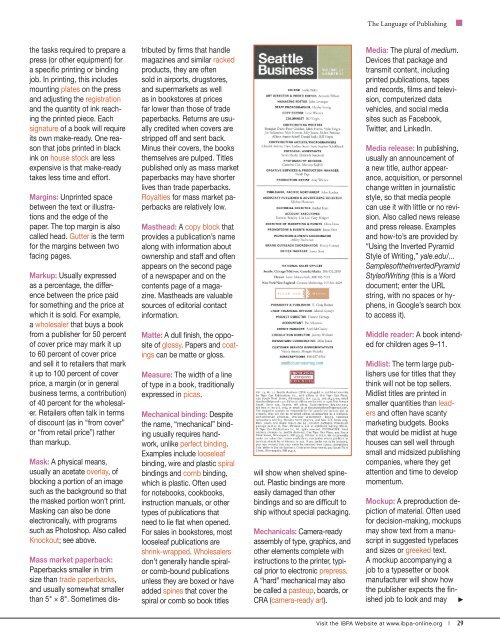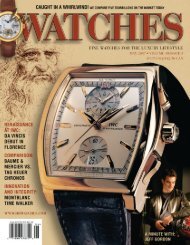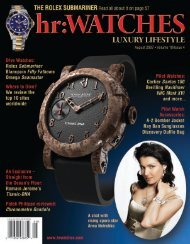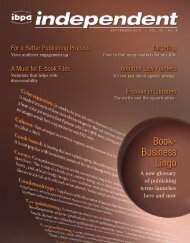Where the Growth Is
Where the Growth Is - Van-garde
Where the Growth Is - Van-garde
- No tags were found...
You also want an ePaper? Increase the reach of your titles
YUMPU automatically turns print PDFs into web optimized ePapers that Google loves.
The Language of Publishing■<strong>the</strong> tasks required to prepare apress (or o<strong>the</strong>r equipment) fora specific printing or bindingjob. In printing, this includesmounting plates on <strong>the</strong> pressand adjusting <strong>the</strong> registrationand <strong>the</strong> quantity of ink reaching<strong>the</strong> printed piece. Eachsignature of a book will requireits own make-ready. One reasonthat jobs printed in blackink on house stock are lessexpensive is that make-readytakes less time and effort.Margins: Unprinted spacebetween <strong>the</strong> text or illustrationsand <strong>the</strong> edge of <strong>the</strong>paper. The top margin is alsocalled head. Gutter is <strong>the</strong> termfor <strong>the</strong> margins between twofacing pages.Markup: Usually expressedas a percentage, <strong>the</strong> differencebetween <strong>the</strong> price paidfor something and <strong>the</strong> price atwhich it is sold. For example,a wholesaler that buys a bookfrom a publisher for 50 percentof cover price may mark it upto 60 percent of cover priceand sell it to retailers that markit up to 100 percent of coverprice, a margin (or in generalbusiness terms, a contribution)of 40 percent for <strong>the</strong> wholesaler.Retailers often talk in termsof discount (as in “from cover”or “from retail price”) ra<strong>the</strong>rthan markup.Mask: A physical means,usually an acetate overlay, ofblocking a portion of an imagesuch as <strong>the</strong> background so that<strong>the</strong> masked portion won’t print.Masking can also be doneelectronically, with programssuch as Photoshop. Also calledKnockout; see above.Mass market paperback:Paperbacks smaller in trimsize than trade paperbacks,and usually somewhat smallerthan 5" × 8". Sometimes distributedby firms that handlemagazines and similar rackedproducts, <strong>the</strong>y are oftensold in airports, drugstores,and supermarkets as wellas in bookstores at pricesfar lower than those of tradepaperbacks. Returns are usuallycredited when covers arestripped off and sent back.Minus <strong>the</strong>ir covers, <strong>the</strong> books<strong>the</strong>mselves are pulped. Titlespublished only as mass marketpaperbacks may have shorterlives than trade paperbacks.Royalties for mass market paperbacksare relatively low.Mas<strong>the</strong>ad: A copy block thatprovides a publication’s namealong with information aboutownership and staff and oftenappears on <strong>the</strong> second pageof a newspaper and on <strong>the</strong>contents page of a magazine.Mas<strong>the</strong>ads are valuablesources of editorial contactinformation.Matte: A dull finish, <strong>the</strong> oppositeof glossy. Papers and coatingscan be matte or gloss.Measure: The width of a lineof type in a book, traditionallyexpressed in picas.Mechanical binding: Despite<strong>the</strong> name, “mechanical” bindingusually requires handwork,unlike perfect binding.Examples include looseleafbinding, wire and plastic spiralbindings and comb binding,which is plastic. Often usedfor notebooks, cookbooks,instruction manuals, or o<strong>the</strong>rtypes of publications thatneed to lie flat when opened.For sales in bookstores, mostlooseleaf publications areshrink-wrapped. Wholesalersdon’t generally handle spiralorcomb-bound publicationsunless <strong>the</strong>y are boxed or haveadded spines that cover <strong>the</strong>spiral or comb so book titleswill show when shelved spineout.Plastic bindings are moreeasily damaged than o<strong>the</strong>rbindings and so are difficult toship without special packaging.Mechanicals: Camera-readyassembly of type, graphics, ando<strong>the</strong>r elements complete withinstructions to <strong>the</strong> printer, typicalprior to electronic prepress.A “hard” mechanical may alsobe called a pasteup, boards, orCRA (camera-ready art).Media: The plural of medium.Devices that package andtransmit content, includingprinted publications, tapesand records, films and television,computerized datavehicles, and social mediasites such as Facebook,Twitter, and LinkedIn.Media release: In publishing,usually an announcement ofa new title, author appearance,acquisition, or personnelchange written in journalisticstyle, so that media peoplecan use it with little or no revision.Also called news releaseand press release. Examplesand how-to’s are provided by“Using <strong>the</strong> Inverted PyramidStyle of Writing,” yale.edu/...Samplesof<strong>the</strong>InvertedPyramidStyleofWriting (this is a Worddocument; enter <strong>the</strong> URLstring, with no spaces or hyphens,in Google’s search boxto access it).Middle reader: A book intendedfor children ages 9–11.Midlist: The term large publishersuse for titles that <strong>the</strong>ythink will not be top sellers.Midlist titles are printed insmaller quantities than leadersand often have scantymarketing budgets. Booksthat would be midlist at hugehouses can sell well throughsmall and midsized publishingcompanies, where <strong>the</strong>y getattention and time to developmomentum.Mockup: A preproduction depictionof material. Often usedfor decision-making, mockupsmay show text from a manuscriptin suggested typefacesand sizes or greeked text.A mockup accompanying ajob to a typesetter or bookmanufacturer will show how<strong>the</strong> publisher expects <strong>the</strong> finishedjob to look and mayVisit <strong>the</strong> IBPA Website at www.ibpa-online.org | 29








